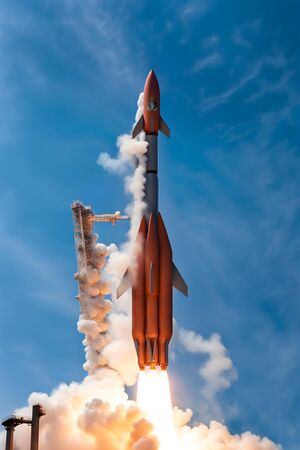Hergom in Space

The Wolgos space program traces its origins back to the year 7669 when it emerged as an integral part of the Wolgos government's broader efforts in nuclear weapons development. Initially, the primary objective of the rocketry program was to design and develop launch vehicles tailored for the delivery of nuclear warheads. Rockets were instrumental in this context, representing a critical component of the nation's strategic offensive capabilities. As negotiations with the International Council of Nations (ICoN) progressed, global long-range delivery methods for nuclear warheads were established, rendering the program's initial purpose somewhat obsolete.
In light of these geopolitical developments and the evolving landscape of international diplomacy, the Wolgos rocketry program underwent a significant transformation. Scientific and prestigious aspirations began to take centre stage, redirecting the program's focus from military applications to peaceful exploration and discovery. By the year 7675, the Wolgos intercontinental ballistic missile (ICBM) program had already started winding down, and expectations of its eventual shelving grew as ICoN sanctions were gradually relaxed.
The turning point arrived in 7676 when the program underwent a complete overhaul and repurposing. It transitioned from being under military jurisdiction to becoming the responsibility of a newly established agency. This transformation allowed the program to diversify its personnel, welcoming not only engineers and technicians but also doctors, scientists, and astronomers into its ranks. This expanded and interdisciplinary team marked the beginning of a new era for the Wolgos space program, one that was characterized by a commitment to scientific exploration, international cooperation, and the advancement of knowledge beyond the boundaries of Gotha's atmosphere.
H1stērh1eukmnt

H1stērh1eukmnt (Stellar Directive), the governing agency of the Wolgos space program, stands as a symbol of unity and exploration in Hergom. This government agency operates with the full backing of Hergom's central authority while collaborating with tribal enterprises, serving as contractors and suppliers in a joint mission of cosmic exploration and scientific discovery.
The agency's primary facilities are located in the tropical haven of Dharmnghel, nestled in the northernmost Aleutian Peninsula coastal plains. Here, under warm tropical skies and occasional seasonal tropical storms, the agency conducts its ground breaking work. Politically, Dharmnghel falls within the Gahnam autonomous zones, yet the territory hosting the agency's activities has been officially designated as part of Hergom's capital territory, reflecting its exceptional significance.
Wolnauts, the intrepid individuals who venture into the cosmos, are recruited predominantly from the ranks of the Hergom Airforce. On certain occasions, the agency may extend invitations to civilian scientists affiliated with esteemed higher education programs. While the agency has welcomed representatives from friendly nations into space, its core focus remains on advancing Hergom's and the Wolgos capabilities in the realm of astronomy and exploration.
It is important to delineate between the agency's esteemed Wolnauts and experimental Eokoesr test subjects. While both contribute to scientific progress, only the former hold the esteemed title of Wolnauts as defined by the agency.
The agency's current mission is a resolute one: to elevate Hergom's prominence in the field of astronomy. This expansive endeavour encompasses weather monitoring, geoscience, astrobiology, astrophysics, and the exploration of our solar system through the deployment of space probes. Equally vital is the agency's commitment to maintaining a continuous presence of Wolgos representatives in the celestial orbit of Gotha, a beacon of Hergom's enduring legacy in the cosmos.
First Wolgos in Space

Bhroghus H2erkusonos, of the Lēudherorēgs tribe, etched his name into history as the very first Wolgos to journey beyond the bounds of Gotha's atmosphere. In the southern spring of the year 7679, at the age of thirty-two, Bhroghus embarked on this remarkable adventure, marking the pinnacle of his career. His selection was the culmination of a rigorous process, competing with a select group of pilots from the nation's airforce. Testing, training, and conditioning prepared him for the challenges that lay ahead.
Bhroghus's orbital voyage around Gotha spanned three awe-inspiring hours. During this momentous journey, he undertook a seven-minute spacewalk outside his capsule—an endeavour considered audacious for a maiden flight. The decision to include a spacewalk was made under the weight of political expectations, despite concerns about its timing and necessity.
The H1trebhghentrom (Slingshot) rocket, an adapted variant of the H1ghn̥h1teghosweiks (Righteous Flame) intercontinental ballistic missile (ICBM), served as Bhroghus's vessel for this historic mission. Measuring 25 meters in length, this modified rocket possessed the capability to transport 2,200 kg into low Gotha orbit (LGO). The aftermath of the non-proliferation treaty had left Hergom with a surplus of non-deployable ICBMs, which found new purpose under the skilled hands of H1stērh1eukmnt. The agency designed and manufactured both a passenger capsule and a satellite delivery capsule, heralding an era of space exploration.
The inaugural H1trebhghentrom rocket launches featured immobilized and often sedated Eokoesr as test subjects. The first launch encountered failure halfway to LGO, while the second reached LGO but resulted in the Eokoesr's demise due to a heart attack brought by panic during the launch. The third launch, however, proved to be the charm—a successful ascent followed by the euthanasia of the Eokoesr via a pre-programmed mechanism before re-entry. The Wolgos chose this path for ideological reasons, deeming it a matter of prestige not to allow their test subjects to return alive to Gotha. The fifth H1trebhghentrom launch, carrying Bhroghus on board, charted a triumphant course to LGO and safely returned to Gotha, culminating in a splashdown near the Hewpes Islands. This historic achievement marked the dawn of Wolgos space exploration and a legacy that would inspire generations to come.
H1sterdhomos space station

The H1sterdhomos Space Station, first stablished in 7688, a compact orbital facility, serves the exclusive scientific needs of Hergom. While smaller in scale compared to larger pan-national space stations, it is fully equipped for advanced research and operational autonomy. Designed for a maximum occupancy of six Wolgos crew members plus two human or various medium sized animal test subjects if required, the H1sterdhomos operates without international collaboration and is restricted to Hergom's astronauts and researchers, emphasizing its national strategic importance in space exploration and research. The station caters for biological, physiological studies and various other engineering, material science and chemistry experimental protocols.
Power Systems: The station is powered by a large array of solar panels, which provide a reliable energy source for all on-board operations. These panels are engineered for high-efficiency output and durability to withstand the harsh conditions of space. The stations battery banks and capacitors can store power for emergency situations and to keep the station operational throughout its dark orbital phases.
Docking Capabilities: A single-capsule docking bay serves as the primary entry and exit point for crew and supplies. The bay features an advanced docking mechanism that can accommodate a variety of capsule types, allowing for flexible resupply missions and crew rotations.
Secondary Airlock: In addition to the primary airlock within the Storage and Utility Module, a secondary airlock is available, primarily used for external maintenance and spacewalks. This ensures operational flexibility and safety for crew members performing external repairs or conducting experiments outside the station.
Modules
The H1sterdhomos comprises five interconnected modules, each serving a specific purpose:
- Storage and Utility Module: Equipped with a 3-way airlock system, this module holds the station's supplies and equipment necessary for maintenance and daily operations. The airlock system also serves as the primary ingress point following capsule docking procedures.
- Command and Control Module: This module houses the station's control systems, enabling crew members to navigate, communicate, and manage the H1sterdhomos's various subsystems. It is compact yet functional, optimized for space utilization and ease of access to control interfaces.
- Living Quarters Module: Designed to accommodate six crew members and two test subjects, this module provides personal space, communal areas, and necessary amenities to maintain morale and psychological health during missions.
- Life Support and Environmental Control Module: Central to crew survival, this module contains systems that recycle air and water, manage waste, and regulate the station's internal environment to ensure a habitable atmosphere.
- Laboratory and Research Module: Outfitted with specialized equipment for conducting a range of experiments in zero-gravity conditions, this module supports ongoing research in life sciences and materials science. The lab contains a farm ring that allows to test zero gravity and low gravity farming. An attached animal & human lab facilitates biological and medical studies as it includes holding pens able to be used as experimental pens and facilities for zero-gravity dissection and vivisection, while an external mount allows for astronomical instruments to be deployed and utilized.

Future expansion
The future of space exploration beckons with exciting possibilities as the agency sets its sights on expanding the capabilities of the space station. Among the ambitious projects currently in the design and construction phase are the manifold module and the thermoelectric small fission reactor. These cutting-edge technologies promise to pave the way for growth and advancement.
The manifold module holds the key to expanding the station's capacity and functionality. Its addition will usher in a new era of scientific exploration and experimentation within the cosmos. With the manifold module in place, the agency envisions the establishment of expanded laboratories, dedicated astronomy modules, and two docking modules. These developments will not only facilitate the station's growth but also enhance its versatility and accommodate a broader range of scientific objectives.
Moreover, the incorporation of a thermoelectric small fission reactor promises to be a game-changer in terms of energy generation and sustainability. This advanced reactor technology will not only power the station but also provide the essential life support capabilities necessary for extended missions and prolonged stays in orbit.